Take a Look Inside one of Vail's Most Environmentally Friendly Homes
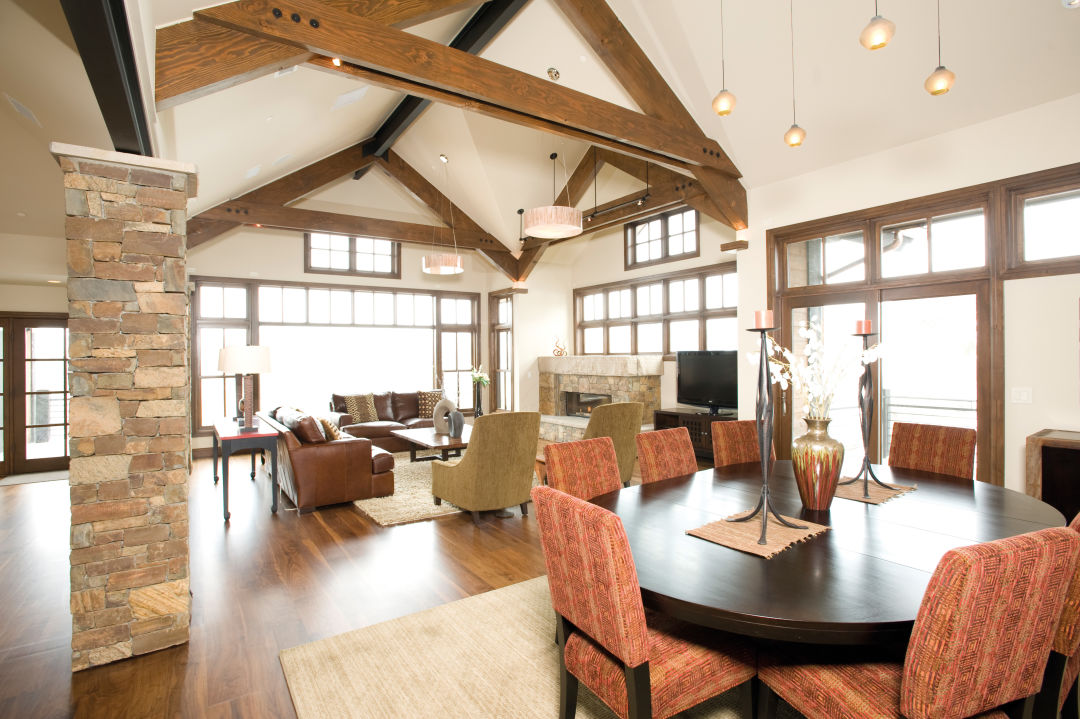
Elegant beams and sustainably harvested walnut floors contribute to what Cindy Eskwith calls “the basketball court look.”
When Cindy Eskwith sweeps her gaze around her spanking-new home atop The Ranch at Cordillera, a part of her almost wishes she didn’t have the house at all. “When we saw this view it just blew our minds,” she says with a gleeful grin, looking through seven-foot-high windows upon a dizzying panorama of mountains rising shoulder-to-shoulder outside. “I’d like to live outside, really; the only reason I live in a house is to keep warm!”
The home she and her husband, Larry, moved into is unusually warm, indeed—by design. It was deliberately built warm, sealed up as tightly as a house-sized zip-lock bag, and outfitted with scores of energy-saving measures and other sustainable features that have earned it LEED (Leadership in Energy and Environmental Design) Silver certification, making it only the second home in the valley to achieve that designation. Other benefits of LEED-oriented construction, such as the mere $200 monthly electric bill (for a 7,444-square-foot home with a heated three-car garage) and a super-clean, white-glove environment requiring almost no dusting (ever!), promise to keep the Eskwiths from moving into the wilds for years to come. As Cindy puts it, “You just end up with a superbly constructed, really quality home.”
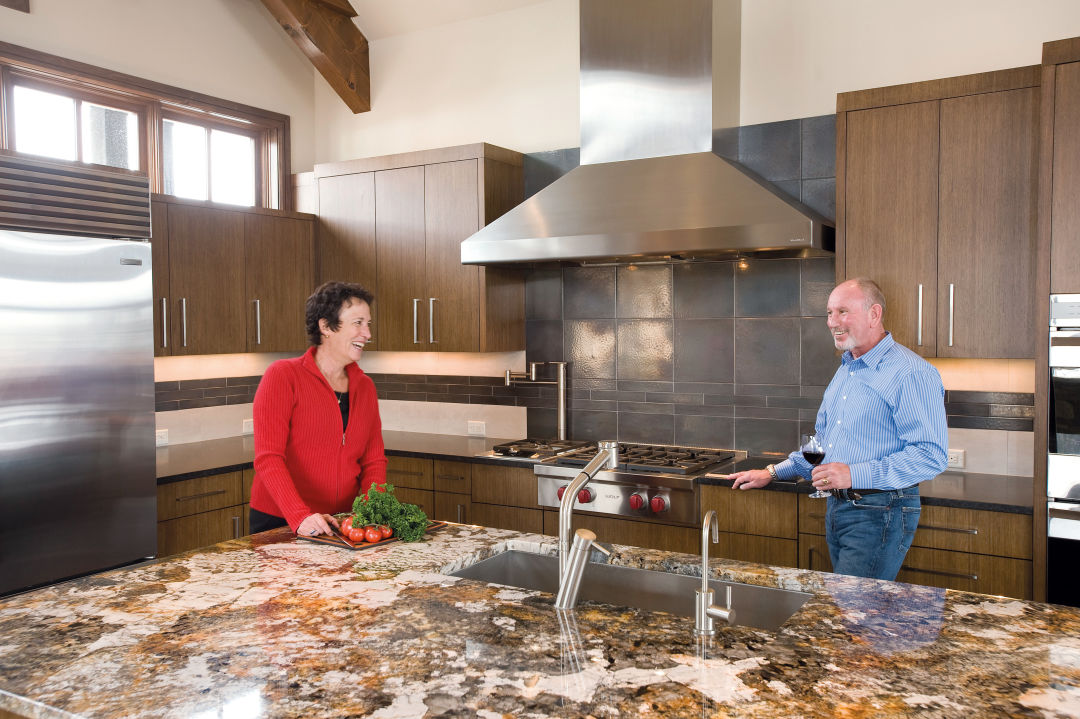
Sustainably harvested bamboo, recycled pewter-tone tile and an energy-efficient induction burner next to the gas range help make an eco-friendly kitchen that Cindy Eskwith calls “a dream to work in.”
The couple had been reading about environmentally correct building for years and was intrigued by the concept. Coincidentally, one of their good friends owned the other Silver LEED home in Cordillera and had enthusiastically endorsed the program’s focus on reducing energy and water consumption, using sustainable building materials and promoting a healthful indoor environment. The momentum built when the Eskwiths, searching for a builder, discovered that Vail Custom Homes was just completing the only LEED Gold certified home around, located in the Cordillera Valley Club. As well, architect Pam Hopkins of Snowdon and Hopkins Architects had experience with the LEED building system’s requirements.
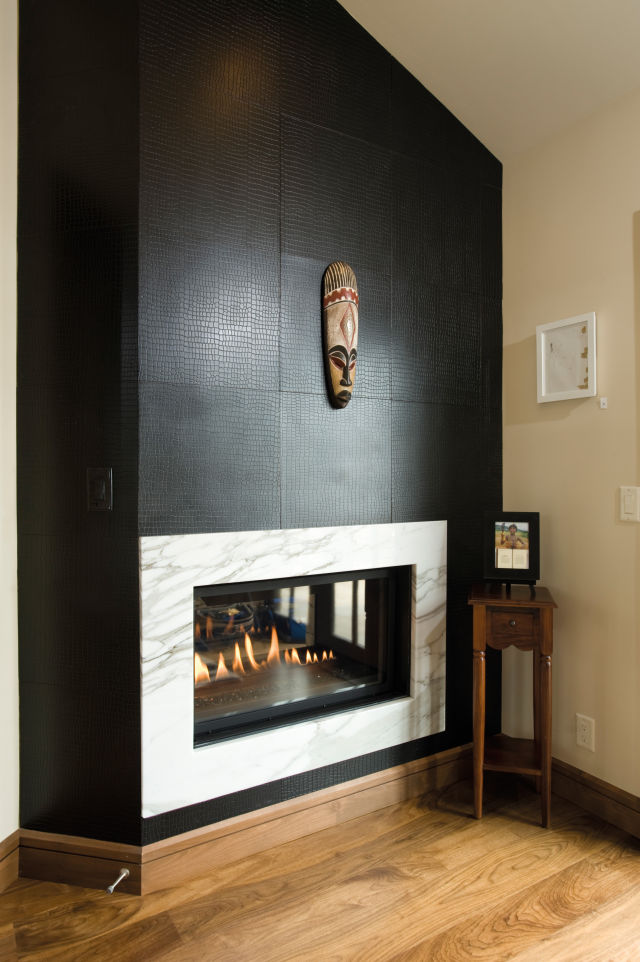
Next to a mask handcrafted in Africa sits a picture of the artist.
For the Eskwiths, as longtime locals, the choice to build green was fueled partly by their belief that it was the right thing to do, and partly by their desire for snugger digs after decades of hearing mountain winds whistling through their previous home in Lake Creek Meadows. Having originally built when elk were their most prominent neighbors and then suffered through several strenuous remodels, the couple considers the Cordillera residence the culmination of their personal odyssey in creating living environs.
“We finally decided to build the home that all along we dreamed about having,” Cindy explains. “And when people come over and ask, ‘Now that it’s all done, what’s the one thing you would change?’ I can honestly say: not a thing.”
From the lustrous walnut floors, sustainably harvested in Germany, to the unpretentiously elegant beams overhead that serve as its bones, the home fairly shines with the thought and care that went into each selection. Divided windows wrap the view around the home and join with the sleek horizontal planes of the open main living space to create a decidedly Prairie atmosphere (and a bow to Frank Lloyd Wright). Kitchen, dining room and living room stretch into one huge space, which Cindy likes to call “the basketball court look”; the expansiveness of these enclosed spaces resonates with the natural grandeur just outside. A studied lack of clutter and the absence of chunky western accents preserve the home’s sense of harmony and serene proportion.
“I’m not a minimalist,” Cindy says, “but I’ll always choose less instead of more.” Definitely not fans of the overstuffed look, the Eskwiths were frustrated when none of the three interior designers they consulted “got it.” Finally, they just pulled everything together themselves, mixing it up with some furniture from Arhaus in Denver; chairs, vases and other pieces from Pier 1; and a down-to-earth palette of rusty reds, chocolate browns and caramels.
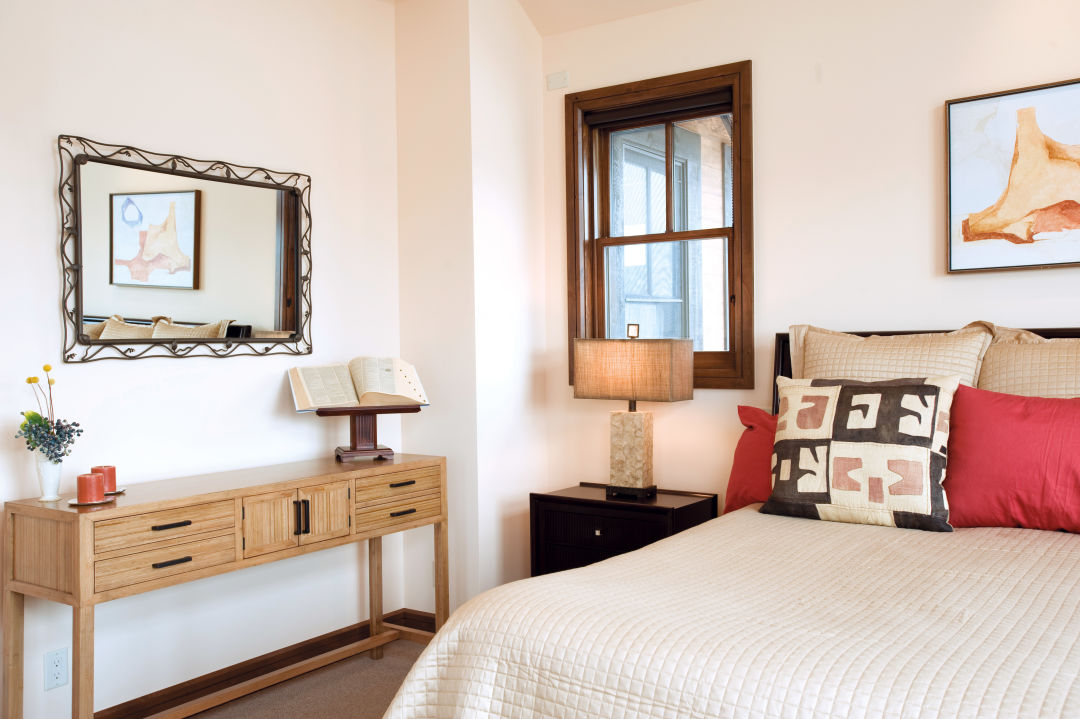
Lampshades throughout the house are made of sustainably harvested sea grasses or natural silks.
At the same time, they embarked on a treasure hunt to locate enviro-friendly details to tuck into each room. The front door handle is made with recycled metal, for example, and one wall of a small office off the entryway—above a marble-girded, two-sided fireplace—is faced with gleaming black leather, previously used for Gucci shoes and BMW car seats, that has been shredded and recycled into a stunning crocodile finish by Eco Domo. But the prize for most audacious recycling goes to the literally green countertop in the family-room bar. It’s composed of real paper money (alas, shredded) obtained from the dead money department of the treasury. Naturally, Cindy and Larry call it the Money Bar.
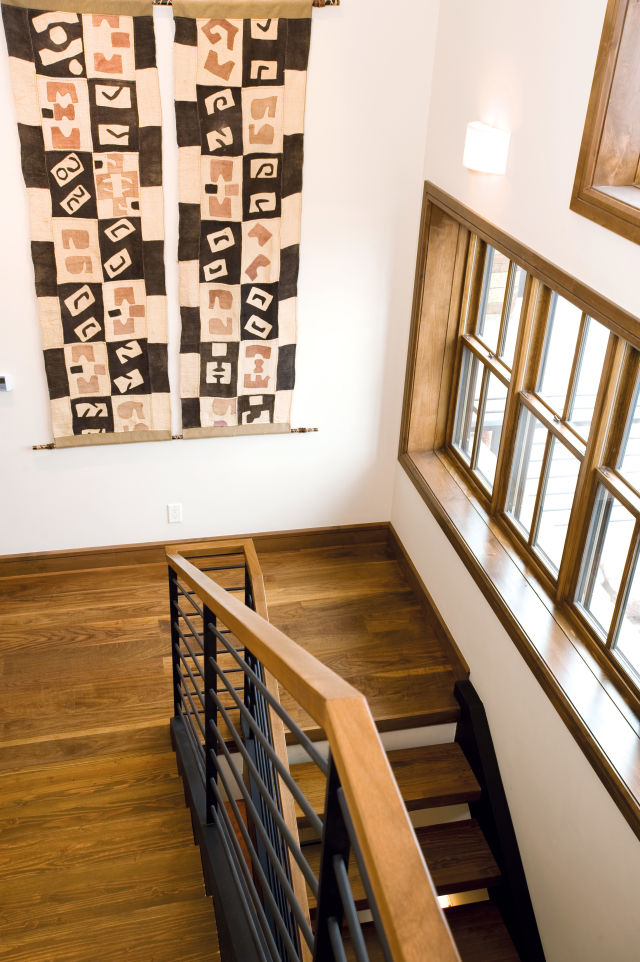
Various wall hangings were also handmade in Africa.
“I enjoyed putting all this together so much—it was the most fun!” says Cindy, who studied art and design in college but ended up with her own accounting business and now owns the Bottle and Cork liquor store in Edwards. The couple became so involved with the details of the living-room fireplace, in fact, that they designed a three-dimensional cardboard model so the masons would know exactly what they had in mind.
Other sustainable details in the six-bedroom, eight-bath home include tile made from lustrous, 100 percent recycled glass in a panorama of hues. The newspaper we all try so faithfully to recycle may well have ended up as this home’s handsome, stone-hard bathroom vanities and shower seats in shades of black and taupe. And local rocks of various sizes constitute each of the home’s seven fireplaces.
As environmentally important as these sustainable materials are, the LEED standards also emphasize air quality. One way the Eskwiths ensured that the air inside their home would be clean and allergen-free was by choosing all-wool carpeting for the bedrooms that was manufactured using natural plant dyes and installed with nontoxic glues. The low-VOC (volatile organic compounds) paint used throughout also boosts indoor air quality by eliminating the chemical toxins and fumes that contribute to that “new home” smell, and in-floor radiant heat instead of ductwork helps keep air its cleanest. And then there’s what Cindy refers to as “the lung.” Whereas most homes get enough leakage through windows and doors that fresh air is always circulating from outside, this home is so tightly insulated that it must “breathe” by constantly expelling the old air and taking in new fresh air, just like a lung—a lung called a Heat Recovery Ventilation System, so named because incoming air is heated by outgoing air in a heat exchanger, thus saving energy.
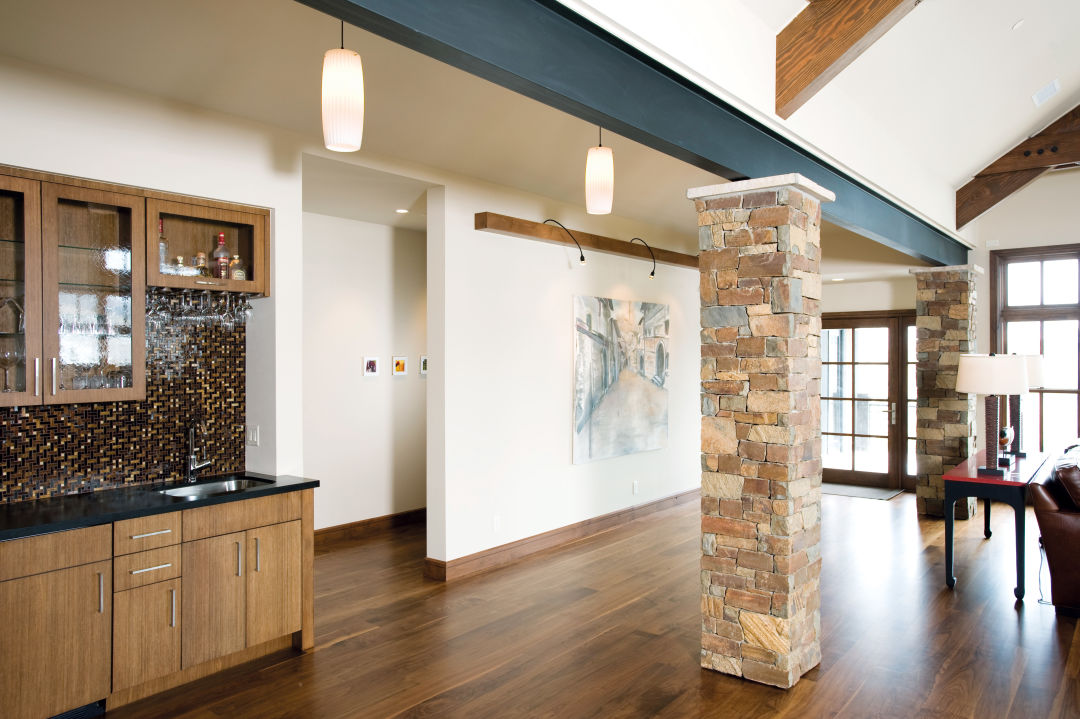
Original artworks by Squaw Creek native Alexis McLean enliven many rooms in the house.
All of the home’s LEED impulses come together in the warm heart of the home, the kitchen. The sleek modern cabinets are crafted of Forest Stewardship Council–certified bamboo, which means the wood came from forests that are sustainably harvested. Fast-growing bamboo is also heralded as an ideal material because it regenerates in only 10 years, as opposed to the 30 years it takes most hardwood trees to mature. Pewter-toned tile on the stovetop backsplash is made of recycled materials and repeated on the island, picking up the glossy silver of the appliances. The Wolf four-burner gas stove is flanked by an oversize wok burner on one side and a modern miracle on the other: two induction burners that are marvels of physics. Cindy puts a big pot of water on for pasta, and it’s boiling in a minute and a half, flat.
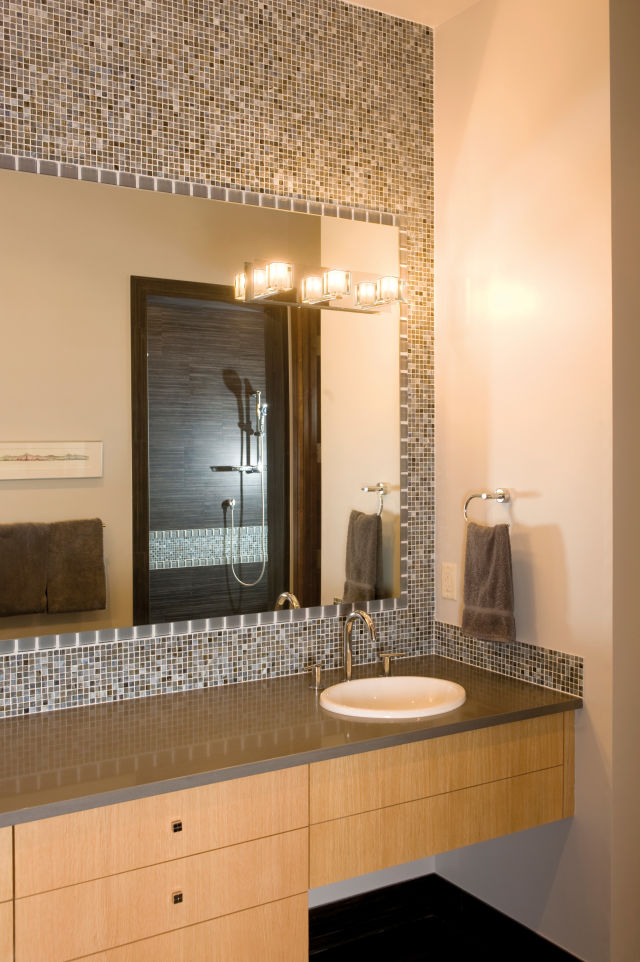
100 percent recycled glass tiles grace the bathrooms.
“The kitchen is a dream to work in,” attests Cindy. “We had five people cooking on Thanksgiving, and they never bumped into each other.” But when it’s just Larry and Cindy dining together, they can flick a switch to enjoy the glow in the fireplace on the outside deck. Looking out from their mountaintop, they sometimes talk about moving to Vail as young marrieds; raising their daughter, Claire; and forming friendships that have lasted for over three decades.
Larry, a lawyer, put in many years as assistant district attorney and then Eagle County district attorney, during the glory days of Vail’s first flush of success. He’s now in private practice as a real estate and contracts attorney. Cindy’s first job here was as Vail founder Pete Seibert’s secretary; then she went back to school and began her accounting practice. When Claire was 5, Cindy got involved in the Vail Valley Soccer Club as president and board member. She helped create the Edwards soccer fields, became a referee and instructor, and started a scholarship program for at-risk kids.
Now their daughter is grown, and the couple is content in their new mountain home. Outside their bedroom hangs a poster of Vail, with a majestic Gore Range background, that was given to Larry at Vail’s 40th Anniversary Founders Banquet in 2002 by Vail Resorts in recognition of his service to the town. The Eskwiths began their lives here with the same optimism and determination that marked Vail itself in those days. Together, both have reached their peak.






































